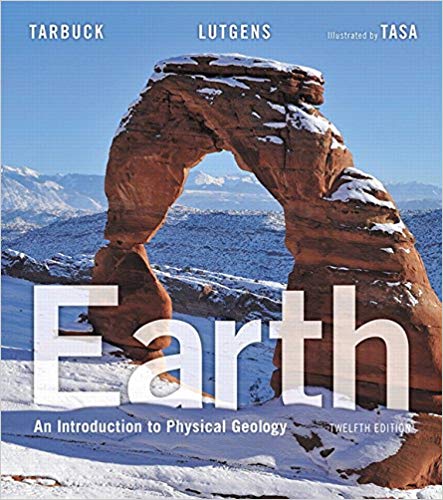This is completed downloadable of Test Bank for Earth: An Introduction to Physical Geology 12th Edition

Product Details:
- ISBN-10 : 0134182596
- ISBN-13 : 978-0134182599
- Author:
With its strong readability and engaging, instructive illustrations, this trusted bestseller returns with a hybrid and streamlined focus on core principles. Earth: An Introduction to Physical Geologymaintains a learning objective-driven approach throughout each chapter: The text provides students with a structured learning path, tied to learning objectives with opportunities for students to demonstrate their understanding at the end of each section. The authors’ emphasis on currency and relevance includes the latest thinking in the field, particularly in the dynamic area of plate tectonics.
The Twelfth Edition, Pearson Science’s first augmented reality, hybrid textbook, uses the BouncePages image recognition app (FREE on both iOS and Android stores) to connect students’ digital devices to the print textbook, enhancing their reading and learning experience. Tarbuck/Lutgens’s innovative SmartFigures feature has been expanded, adding new digital content via Project Condor, Mobile Field Trips by Michael Collier, Animated Figures, and additional tutorial videos from Callan Bentley.This edition also includes MasteringGeology, the most complete, easy-to-use, engaging tutorial and assessment tool available.
Table of Content:
- Chapter 1: An Introduction to Geology
- 1.1: Geology: The Science of Earth
- Physical and Historical Geology
- Geology, People, and the Environment
- Geo Graphics 1.1: World Population Passes 7 Billion
- 1.2: The Development of Geology
- Catastrophism
- The Birth of Modern Geology
- Geology Today
- The Magnitude of Geologic Time
- 1.3: The Nature of Scientific Inquiry
- Hypothesis
- Theory
- Scientific Methods
- Plate Tectonics and Scientific Inquiry
- 1.4: Earth as a System
- Earth’s Spheres
- Earth System Science
- The Earth System
- 1.5: Origin and Early Evolution of Earth
- Origin of Our Solar System
- Geo Graphics 1.2: Solar System: Size and Scale
- Formation of Earth’s Layered Structure
- 1.6: Earth’s Internal Structure
- Earth’s Crust
- Earth’s Mantle
- Earth’s Core
- 1.7: Rocks and the Rock Cycle
- The Basic Cycle
- Alternative Paths
- 1.8: The Face of Earth
- Major Features of the Ocean Floor
- Major Features of the Continents
- Concepts in Review
- Chapter 2: Plate Tectonics: A Scientific Revolution Unfolds
- 2.1: From Continental Drift to Plate Tectonics
- 2.2: Continental Drift: An Idea Before Its Time
- Evidence: The Continental Jigsaw Puzzle
- Evidence: Fossils Matching Across the Seas
- Evidence: Rock Types and Geologic Features
- Evidence: Ancient Climates
- 2.3: The Great Debate
- Rejection of the Drift Hypothesis
- 2.4: The Theory of Plate Tectonics
- Rigid Lithosphere Overlies Weak Asthenosphere
- Earth’s Major Plates
- Plate Movement
- 2.5: Divergent Plate Boundaries and Seafloor Spreading
- Oceanic Ridges and Seafloor Spreading
- Continental Rifting
- 2.6: Convergent Plate Boundaries and Subduction
- Oceanic-Continental Convergence
- Oceanic-Oceanic Convergence
- Continental-Continental Convergence
- 2.7: Transform Plate Boundaries
- 2.8: How Do Plates and Plate Boundaries Change?
- The Breakup of Pangaea
- Plate Tectonics in the Future
- 2.9: Testing the Plate Tectonics Model
- Evidence: Ocean Drilling
- Evidence: Mantle Plumes and Hot Spots
- Evidence: Paleomagnetism
- 2.10 How Is Plate Motion Measured?
- Geologic Measurement of Plate Motion
- Measuring Plate Motion from Space
- 2.11 What Drives Plate Motions?
- Forces That Drive Plate Motion
- Models of Plate-Mantle Convection
- Concepts in Review
- Chapter 3: Matter and Minerals
- 3.1: Minerals: Building Blocks of Rocks
- Defining a Mineral
- What Is a Rock?
- 3.2: Atoms: Building Blocks of Minerals
- Properties of Protons, Neutrons, and Electrons
- Elements: Defined by Their Number of Protons
- 3.3: Why Atoms Bond
- The Octet Rule and Chemical Bonds
- Ionic Bonds: Electrons Transferred
- Covalent Bonds: Electron Sharing
- Metallic Bonds: Electrons Free to Move
- Hybrid Bonds
- 3.4: How Do Minerals Form?
- Precipitation of Mineral Matter
- Crystallization of Molten Rock
- Geo Graphics 3.1: Gold
- Deposition as a Result of Biological Processes
- 3.5: Properties of Minerals
- Optical Properties
- Crystal Shape, or Habit
- Mineral Strength
- Density and Specific Gravity
- Other Properties of Minerals
- 3.6: Mineral Structures and Compositions
- Mineral Structures
- Compositional Variations in Minerals
- Structural Variations in Minerals
- 3.7: Mineral Groups
- Classifying Minerals
- Silicate Versus Nonsilicate Minerals
- 3.8: The Silicates
- Silicate Structures
- Joining Silicate Structures
- 3.9: Common Silicate Minerals
- The Light Silicates
- The Dark Silicates
- 3.10: Important Nonsilicate Minerals
- Geo Graphics 3.2: Gemstones
- Concepts in Review
- Chapter 4: Magma, Igneous Rocks, and Intrusive Activity
- 4.1: Magma: Parent Material of Igneous Rock
- The Nature of Magma
- From Magma to Crystalline Rock
- Igneous Processes
- 4.2: Igneous Compositions
- Granitic (Felsic) Versus Basaltic (Mafic) Compositions
- Other Compositional Groups
- Silica Content as an Indicator of Composition
- 4.3: Igneous Textures: What Can They Tell Us?
- Types of Igneous Textures
- 4.4: Naming Igneous Rocks
- Granitic (Felsic) Igneous Rocks
- Andesitic (Intermediate) Igneous Rocks
- Basaltic (Mafic) Igneous Rocks
- Pyroclastic Rocks
- Geo Graphics 4.1: Granite: An Intrusive Igneous Rock
- 4.5: Origin of Magma
- Generating Magma from Solid Rock
- 4.6: How Magmas Evolve
- Bowen’s Reaction Series and the Composition of Igneous Rocks
- Magmatic Differentiation and Crystal Settling
- Assimilation and Magma Mixing
- 4.7 Partial Melting and Magma Composition
- Formation of Basaltic Magma
- Formation of Andesitic and Granitic Magmas
- 4.8: Intrusive Igneous Activity
- Nature of Intrusive Bodies
- Tabular Intrusive Bodies: Dikes and Sills
- Massive Intrusive Bodies: Batholiths, Stocks, and Laccoliths
- Concepts in Review
- Chapter 5: Volcanoes and Volcanic Hazards
- 5.1: The Nature of Volcanic Eruptions
- Factors Affecting Viscosity
- Quiescent Versus Explosive Eruptions
- 5.2: Materials Extruded During an Eruption
- Lava Flows
- Geo Graphics 5.1: Eruption of Mount St. Helens
- Gases
- Pyroclastic Materials
- 5.3: Anatomy of a Volcano
- 5.4: Shield Volcanoes
- Shield Volcanoes of Hawaii
- Evolution of Volcanic Islands
- 5.5: Cinder Cones
- Geo Graphics 5.2: Kilauea’s East Rift Zone Eruption
- Parícutin: Life of a Garden-Variety Cinder Cone
- 5.6: Composite Volcanoes
- 5.7: Volcanic Hazards
- Pyroclastic Flow: A Deadly Force of Nature
- Lahars: Mudflows on Active and Inactive Cones
- Other Volcanic Hazards
- 5.8: Other Volcanic Landforms
- Calderas
- Fissure Eruptions and Basalt Plateaus
- Lava Domes
- Volcanic Necks and Pipes
- 5.9: Plate Tectonics and Volcanic Activity
- Volcanism at Convergent Plate Boundaries
- Volcanism at Divergent Plate Boundaries
- Intraplate Volcanism
- 5.10: Monitoring Volcanic Activity
- Concepts in Review
- Chapter 6: Weathering and Soils
- 6.1: Weathering
- 6.2: Mechanical Weathering
- Frost Wedging
- Salt Crystal Growth
- Sheeting
- Geo Graphics 6.1: Some Everyday Examples of Weathering
- Geo Graphics 6.2: The Old Man of the Mountain
- Biological Activity
- 6.3: Chemical Weathering
- Dissolution
- Oxidation
- Hydrolysis
- Spheroidal Weathering
- 6.4: Rates of Weathering
- Rock Characteristics
- Climate
- Differential Weathering
- 6.5: Soil
- An Interface in the Earth System
- What Is Soil?
- Soil Texture and Structure
- 6.6: Controls of Soil Formation
- Parent Material
- Climate
- Plants and Animals
- Time
- Topography
- 6.7: Describing and Classifying Soils
- The Soil Profile
- Classifying Soils
- 6.8: The Impact of Human Activities on Soil
- Clearing the Tropical Rain Forest: A Case Study of Human Impact on Soil
- Soil Erosion: Losing a Vital Resource
- Geo Graphics 6.3: The 1930s Dust Bowl: An Environmental Disaster
- Concepts in Review
- Chapter 7: Sedimentary Rocks
- 7.1: An Introduction to Sedimentary Rocks
- Importance
- Origins
- 7.2: Detrital Sedimentary Rocks
- Shale
- Sandstone
- Conglomerate and Breccia
- 7.3: Chemical Sedimentary Rocks
- Limestone
- Geo Graphics 7.1: Limestone: An Important and Versatile Commodity
- Dolostone
- Chert
- Evaporites
- 7.4: Coal: An Organic Sedimentary Rock
- 7.5: Turning Sediment into Sedimentary Rock: Diagenesis and Lithification
- Diagenesis
- Lithification
- 7.6: Classification of Sedimentary Rocks
- 7.7: Sedimentary Rocks Represent Past Environments
- Types of Sedimentary Environments
- Sedimentary Facies
- Sedimentary Structures
- 7.8: The Carbon Cycle and Sedimentary Rocks
- Concepts in Review
- Chapter 8: Metamorphism and Metamorphic Rocks
- 8.1: What Is Metamorphism?
- 8.2: What Drives Metamorphism?
- Heat as a Metamorphic Agent
- Confining Pressure
- Differential Stress
- Chemically Active Fluids
- The Importance of Parent Rock
- 8.3: Metamorphic Textures
- Foliation
- Foliated Textures
- Other Metamorphic Textures
- 8.4: Common Metamorphic Rocks
- Foliated Metamorphic Rocks
- Nonfoliated Metamorphic Rocks
- 8.5: Metamorphic Environments
- Geo Graphics 8.1: Marble
- Contact, or Thermal, Metamorphism
- Hydrothermal Metamorphism
- Burial and Subduction Zone Metamorphism
- Regional Metamorphism
- Other Metamorphic Environments
- Geo Graphics 8.2: Impact Metamorphism
- 8.6: Metamorphic Zones
- Textural Variations
- Index Minerals and Metamorphic Grade
- 8.7: Interpreting Metamorphic Environments
- Common Metamorphic Facies
- Metamorphic Facies and Plate Tectonics
- Mineral Stability and Metamorphic Environments
- Concepts in Review
- Chapter 9: Geologic Time
- 9.1: Creating a Time Scale: Relative Dating Principles
- The Importance of a Time Scale
- Numerical and Relative Dates
- Principle of Superposition
- Principle of Original Horizontality
- Principle of Lateral Continuity
- Principle of Cross-Cutting Relationships
- Principle of Inclusions
- Unconformities
- Applying Relative Dating Principles
- Geo Graphics 9.1: Dating the Lunar Surface
- 9.2: Fossils: Evidence of Past Life
- Types of Fossils
- Conditions Favoring Preservation
- Geo Graphics 9.2: How is paleontology different from archaeology?
- 9.3: Correlation of Rock Layers
- Correlation Within Limited Areas
- Fossils and Correlation
- 9.4: Numerical Dating with Radioactivity
- Reviewing Basic Atomic Structure
- Radioactivity
- Radiometric Dating
- Using Radioactive Isotopes
- Dating with Carbon-14
- 9.5: The Geologic Time Scale
- Structure of the Time Scale
- Precambrian Time
- Terminology and the Geologic Time Scale
- 9.6: Determining Numerical Dates for Sedimentary Strata
- Concepts in Review
- Chapter 10: Crustal Deformation
- 10.1: What Causes Rock to Deform?
- Stress: The Force That Deforms Rocks
- Strain: A Change in Shape Caused by Stress
- 10.2: How Do Rocks Deform?
- Types of Deformation
- Factors That Affect Rock Strength
- Ductile Versus Brittle Deformation and the Resulting Rock Structures
- 10.3: Folds: Rock Structures Formed by Ductile Deformation
- Anticlines and Synclines
- Domes and Basins
- Monoclines
- 10.4: Faults and Joints: Rock Structures Formed by Brittle Deformation
- Dip-Slip Faults
- Strike-Slip Faults
- Oblique-Slip Faults
- What Do Faults Have in Common?
- Geo Graphics 10.1: The San Andreas Fault System
- Joints
- 10.5: Mapping Geologic Structures
- Strike and Dip
- Concepts in Review
- Chapter 11: Earthquakes and Earthquake Hazards
- 11.1: What Is an Earthquake?
- Discovering the Causes of Earthquakes
- Aftershocks and Foreshocks
- 11.2: Faults and Earthquakes
- Normal Faults and Divergent Plate Boundaries
- Thrust Faults and Convergent Plate Boundaries
- Strike-slip Faults and Transform Plate Boundaries
- Fault Rupture and Propagation
- 11.3: Seismology: The Study of Earthquake Waves
- Instruments That Record Earthquakes
- Seismic Waves
- 11.4: Locating the Source of an Earthquake
- 11.5: Determining the Size of an Earthquake
- Intensity Scales
- Magnitude Scales
- 11.6: Earthquake Destruction
- Destruction from Seismic Vibrations
- Landslides and Ground Subsidence
- Fire
- What Is a Tsunami?
- 11.7: Where Do Most Earthquakes Occur?
- Earthquakes Associated with Plate Boundaries
- Damaging Earthquakes East of the Rockies
- 11.8: Can Earthquakes Be Predicted?
- Short-Range Predictions
- Geo Graphics 11.1: Seismic Risks on the San Andreas Fault System
- Long-Range Forecasts
- Concepts in Review
- Chapter 12: Earth’s Interior
- 12.1: Earth’s Internal Structure
- Gravity and Earth’s Layers
- How Does Gravity Affect Density?
- 12.2: Probing Earth’s Interior
- “Seeing” Seismic Waves
- Seismic Velocities
- Interactions Between Seismic Waves and Earth’s Layers
- 12.3: Earth’s Layers
- Crust
- Geo Graphics 12.1: Recreating the Deep Earth
- Mantle
- Core
- 12.4: Earth’s Temperature
- Heat Flow
- Earth’s Temperature Profile
- 12.5: Earth’s Three-Dimensional Structure
- Earth’s Gravity
- Seismic Tomography
- Earth’s Magnetic Field
- Concepts in Review
- Chapter 13: Origin and Evolution of the Ocean Floor
- 13.1: An Emerging Picture of the Ocean Floor
- Mapping the Seafloor
- Provinces of the Ocean Floor
- 13.2: Continental Margins
- Passive Continental Margins
- Active Continental Margins
- 13.3: Features of Deep-Ocean Basins
- Deep-Ocean Trenches
- Abyssal Plains
- Volcanic Structures on the Ocean Floor
- Geo Graphics 13.1: Explaining Coral Atolls: Darwin’s Hypothesis
- 13.4: Anatomy of the Oceanic Ridge
- 13.5: Oceanic Ridges and Seafloor Spreading
- Seafloor Spreading
- Why Are Oceanic Ridges Elevated?
- Spreading Rates and Ridge Topography
- 13.6: The Nature of Oceanic Crust
- How Does Oceanic Crust Form?
- Interactions Between Seawater and Oceanic Crust
- 13.7: Continental Rifting: The Birth of a New Ocean Basin
- Evolution of an Ocean Basin
- Geo Graphics 13.2: Deep-Sea Hydrothermal Vents
- Mechanisms for Continental Rifting
- 13.8: Destruction of Oceanic Lithosphere
- Why Oceanic Lithosphere Subducts
- Subducting Plates: The Demise of Ocean Basins
- Concepts in Review
- Chapter 14: Mountain Building
- 14.1: Mountain Building
- 14.2: Subduction Zones
- Features of Subduction Zones
- Extension and Back-Arc Spreading
- 14.3: Subduction and Mountain Building
- Island Arc-Type Mountain Building
- Andean-Type Mountain Building
- Sierra Nevada, Coast Ranges, and Great Valley
- 14.4: Collisional Mountain Belts
- Cordilleran-Type Mountain Building
- Alpine-Type Mountain Building: Continental Collisions
- The Himalayas
- The Appalachians
- 14.5: Fault-Block Mountains
- The Basin and Range Province
- 14.6: What Causes Earth’s Varied Topography?
- The Principle of Isostasy
- How Is Isostasy Related to Changes in Elevation?
- Geo Graphics 14.1: The Laramide Rockies
- How High Is Too High?
- Mantle Convection: A Cause of Vertical Crustal Movement
- Concepts in Review
- Chapter 15: Mass Wasting: The Work of Gravity
- 15.1: The Importance of Mass Wasting
- Landslides as Geologic Hazards
- The Role of Mass Wasting in Landform Development
- Slopes Change Through Time
- Geo Graphics 15.1: Landslides as Natural Disasters
- 15.2: Controls and Triggers of Mass Wasting
- The Role of Water
- Oversteepened Slopes
- Removal of Vegetation
- Earthquakes as Triggers
- Landslides Without Triggers?
- 15.3: Classification of Mass-Wasting Processes
- Type of Material
- Type of Motion
- Geo Graphics 15.2: Landslide Risks: United States and Worldwide
- Rate of Movement
- 15.4: Rapid Forms of Mass Wasting
- Slump
- Rockslide
- Debris Flow
- Earthflow
- 15.5: Slow Movements
- Creep
- Solifluction
- The Sensitive Permafrost Landscape
- Concepts in Review
- Chapter 16: Running Water
- 16.1: Earth as a System: The Hydrologic Cycle
- 16.2: Running Water
- Drainage Basins
- River Systems
- Drainage Patterns
- 16.3: Streamflow Characteristics
- Factors Affecting Flow Velocity
- Geo Graphics 16.1: What Are the Largest Rivers?
- Changes Downstream
- 16.4: The Work of Running Water
- Stream Erosion
- Transport of Sediment by Streams
- Deposition of Sediment by Streams
- 16.5: Stream Channels
- Bedrock Channels
- Alluvial Channels
- 16.6: Shaping Stream Valleys
- Base Level and Graded Streams
- Valley Deepening
- Valley Widening
- Incised Meanders and Stream Terraces
- 16.7: Depositional Landforms
- Deltas
- The Mississippi River Delta
- Natural Levees
- Alluvial Fans
- 16.8: Floods and Flood Control
- Types of Floods
- Geo Graphics 16.2: Flash Floods
- Flood Recurrence Intervals
- Flood Control
- Concepts in Review
- Chapter 17: Groundwater
- 17.1: The Importance of Groundwater
- Groundwater and the Hydrosphere
- Geologic Importance of Groundwater
- Groundwater: A Basic Resource
- 17.2: Groundwater and the Water Table
- Distribution of Groundwater
- Variations in the Water Table
- 17.3: Factors Influencing the Storage and Movement of Groundwater
- Porosity
- Permeability, Aquitards, and Aquifers
- 17.4: How Groundwater Moves
- A Simple Groundwater Flow System
- Measuring Groundwater Movement
- Different Scales of Movement
- 17.5: Wells and Artesian Systems
- Wells
- Artesian Systems
- 17.6: Springs, Hot Springs, and Geysers
- Springs
- Hot Springs
- Geysers
- 17.7: Environmental Problems
- Mining Groundwater
- Subsidence
- Geo Graphics 17.1: Drought Impacts the Hydrologic System
- Saltwater Intrusion
- Groundwater Contamination
- 17.8: The Geologic Work of Groundwater
- Caverns
- Karst Topography
- Concepts in Review
- Chapter 18: Glaciers and Glaciation
- 18.1: Glaciers: A Part of Two Basic Cycles
- Valley (Alpine) Glaciers
- Ice Sheets
- Other Types of Glaciers
- Geo Graphics 18.1: Antarctica Fact File
- 18.2: Formation and Movement of Glacial Ice
- Glacial Ice Formation
- How Glaciers Move
- Observing and Measuring Movement
- Budget of a Glacier: Accumulation Versus Wastage
- 18.3: Glacial Erosion
- How Glaciers Erode
- Landforms Created by Glacial Erosion
- 18.4: Glacial Deposits
- Glacial Drift
- Landforms Made of Till
- Landforms Made of Stratified Drift
- 18.5: Other Effects of Ice Age Glaciers
- Crustal Subsidence and Rebound
- Sea-Level Changes
- Changes to Rivers and Valleys
- Ice Dams Create Proglacial Lakes
- Pluvial Lakes
- 18.6: The Ice Age
- Historical Development of the Glacial Theory
- Causes of Ice Ages
- Concepts in Review
- Chapter 19: Deserts and Wind
- 19.1: Distribution and Causes of Dry Lands
- What Is Meant by Dry
- Subtropical Deserts and Steppes
- Middle-Latitude Deserts and Steppes
- 19.2: Geologic Processes in Arid Climates
- Dry-Region Weathering
- The Role of Water
- 19.3: Basin and Range: The Evolution of a Desert Landscape
- Geo Graphics 19.1: Common Misconceptions About Deserts
- 19.4: Transportation of Sediment by Wind
- Bed Load
- Suspended Load
- 19.5: Wind Erosion
- Deflation and Blowouts
- Desert Pavement
- Ventifacts and Yardangs
- 19.6: Wind Deposits
- Sand Deposits
- Types of Sand Dunes
- Loess (Silt) Deposits
- Concepts in Review
- Chapter 20: Shorelines
- 20.1: The Shoreline: A Dynamic Interface
- The Coastal Zone
- Basic Features of the Coastal Zone
- 20.2: Ocean Waves
- Wave Characteristics
- Circular Orbital Motion
- Waves in the Surf Zone
- 20.3: Shoreline Processes
- Wave Erosion
- Sand Movement on the Beach
- 20.4: Shoreline Features
- Erosional Features
- Depositional Features
- The Evolving Shore
- 20.5: Contrasting America’s Coasts
- Coastal Classification
- Atlantic and Gulf Coasts
- Pacific Coast
- Geo Graphics 20.1: A Brief Tour of America’s Coasts
- 20.6: Hurricanes: The Ultimate Coastal Hazard
- Profile of a Hurricane
- Hurricane Destruction
- Detecting and Tracking Hurricanes
- 20.7: Stabilizing the Shore
- Hard Stabilization
- Alternatives to Hard Stabilization
- 20.8: Tides
- Causes of Tides
- Monthly Tidal Cycle
- Tidal Patterns
- Tidal Currents
- Concepts in Review
- Chapter 21: Global Climate Change
- 21.1: Climate and Geology
- The Climate System
- Climate-Geology Connections
- 21.2: Detecting Climate Change
- Climates Change
- Proxy Data
- Seafloor Sediment: A Storehouse of Climate Data
- Oxygen Isotope Analysis
- Climate Change Recorded in Glacial Ice
- Tree Rings: Archives of Environmental History
- Other Types of Proxy Data
- 21.3: Some Atmospheric Basics
- Composition of the Atmosphere
- Extent and Structure of the Atmosphere
- 21.4: Heating the Atmosphere
- Energy from the Sun
- The Paths of Incoming Solar Energy
- Heating the Atmosphere: The Greenhouse Effect
- 21.5: Natural Causes of Climate Change
- Plate Movements and Orbital Variations
- Volcanic Activity and Climate Change
- Solar Variability and Climate
- 21.6: Human Impact on Global Climate
- Rising CO2 Levels
- The Atmosphere’s Response
- The Role of Trace Gases
- How Aerosols Influence Climate
- 21.7: Climate-Feedback Mechanisms
- Types of Feedback Mechanisms
- Computer Models of Climate: Important yet Imperfect Tools
- 21.8: Some Consequences of Global Warming
- Sea-Level Rise
- The Changing Arctic
- Increasing Ocean Acidity
- The Potential for “Surprises”
- Concepts in Review
- Chapter 22: Earth’s Evolution Through Geologic Time
- 22.1: Is Earth Unique?
- The Right Planet
- The Right Location
- The Right Time
- Viewing Earth’s History
- 22.2: Birth of a Planet
- From the Big Bang to Heavy Elements
- From Planetesimals to Protoplanets
- Earth’s Early Evolution
- 22.3: Origin and Evolution of the Atmosphere and Oceans
- Earth’s Primitive Atmosphere
- Oxygen in the Atmosphere
- Evolution of the Oceans
- 22.4: Precambrian History: The Formation of Earth’s Continents
- Earth’s First Continents
- The Making of North America
- Supercontinents of the Precambrian
- 22.5: Geologic History of the Phanerozoic: The Formation of Earth’s Modern Continents
- Paleozoic History
- Mesozoic History
- Cenozoic History
- 22.6: Earth’s First Life
- Origin of Life
- Earth’s First Life: Prokaryotes
- 22.7: Paleozoic Era: Life Explodes
- Early Paleozoic Life-Forms
- Vertebrates Move to Land
- Reptiles: The First True Terrestrial Vertebrates
- The Great Permian Extinction
- 22.8: Mesozoic Era: Age of the Dinosaurs
- Gymnosperms: The Dominant Mesozoic Trees
- Reptiles Take Over the Land, Sea, and Sky
- Demise of the Dinosaurs
- 22.9: Cenozoic Era: Age of Mammals
- From Reptiles to Mammals
- Marsupial and Placental Mammals
- Humans: Mammals with Large Brains and Bipedal Locomotion
- Large Mammals and Extinction
- Concepts in Review
- Chapter 23: Energy and Mineral Resources
- 23.1: Renewable and Nonrenewable Resources
- 23.2: Energy Resources: Fossil Fuels
- Coal
- Geo Graphics 23.1: Coal: A Major Energy Source
- Oil and Natural Gas
- 23.3: Nuclear Energy
- Uranium
- Concerns Regarding Nuclear Development
- 23.4: Renewable Energy
- Solar Energy
- Wind Energy
- Hydroelectric Power
- Geothermal Energy
- Biomass: Renewable Energy from Plants and Animals
- Tidal Power
- 23.5: Mineral Resources
- 23.6: Igneous and Metamorphic Processes
- Magmatic Differentiation and Ore Deposits
- Hydrothermal Deposits
- Origin of Diamonds
- Metamorphic Processes
- 23.7: Mineral Resources Related to Surface Processes
- Weathering and Ore Deposits
- Placer Deposits
- 23.8: Nonmetallic Mineral Resources
- Building Materials
- Industrial Minerals
- Concepts in Review
- Chapter 24: Touring Our Solar System
- 24.1: Our Solar System: An Overview
- Nebular Theory: Formation of the Solar System
- The Planets: Internal Structures and Atmospheres
- Planetary Impacts
- 24.2: Earth’s Moon: A Chip off the Old Block
- How Did the Moon Form?
- 24.3: Terrestrial Planets
- Mercury: The Innermost Planet
- Venus: The Veiled Planet
- Mars: The Red Planet
- Geo Graphics 24.1: Mars Exploration
- 24.4: Jovian Planets
- Jupiter: Lord of the Heavens
- Saturn: The Elegant Planet
- Uranus and Neptune: Twins
- 24.5: Small Solar System Bodies
- Asteroids: Leftover Planetesimals
- Geo Graphics 24.2: Is Earth on a Collision Course?
- Comets: Dirty Snowballs
- Meteoroids: Visitors to Earth
- Dwarf Planets
- Concepts in Review
- Appendix A: Metric and English Units Compared
- Glossary
- Index





